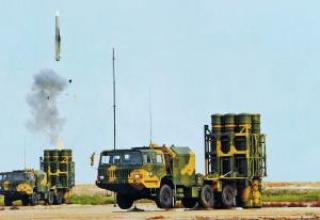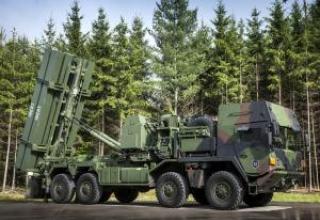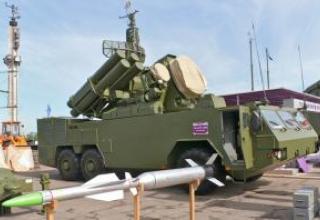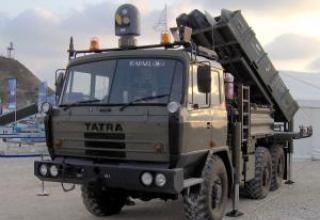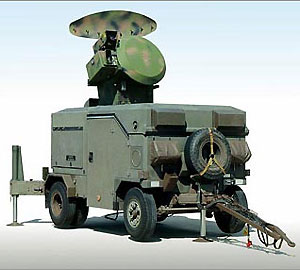
The fire control system "Skyguard", created in the late 70's, has now undergone several stages of modernization and is in service with the armies of many foreign countries: Argentina, Austria, Canada, Egypt, Greece, Malaysia, Saudi Arabia, Oman, United Arab Emirates. It is designed to collect, process and analyse data on an air enemy operating at low and extremely low altitudes, as well as to remotely control the firing of its weapons (anti-aircraft guns and missiles).
The high performance, the possibility of interfacing with various firing systems and the widespread use of the Skyguard system in the armies of many States have made it possible to create on its basis modern anti-aircraft missile and artillery systems (SAM) with minimal cost and in a relatively short time. The Swiss firm Oerlikon Contraves, together with the South African company Kentron, developed the highly effective Skyguard-SAHV system. The complex uses remote-controlled twin 35 mm GDF anti-aircraft guns of modifications 002, 003 and 005 by Oerlikon Contraves and SAHV-IR (South Africa) anti-aircraft guided missiles.
The most likely potential customer for the Skyguard-SAHV system is the South African Army, which has SAHV-IR surface-to-air missiles and a large number of GDF cannons, which are operated by the outdated Super Fleder-Mouse system. In addition, it is estimated to have a very high potential for sale on the world arms market.
Composition:
The complex "Skyguard-SAHV" includes:
- Skyguard II fire control system
- one or two launchers with SAHV-IR (Surface-to-Air High Velocity - Infrared) anti-aircraft guided missiles.
- two 35mm anti-aircraft automatic guns.
All elements in the transport position are towed by off-road vehicles.
The system has high immunity to interference due to the comprehensive use of many technical solutions, the main of which are a wide range of tuning the frequency of the sounding signal of the air view radar, processing data from several detection devices that perform their functions in different areas of the electromagnetic spectrum, and compensation for passive interference. It is equipped with antimissile launch warning equipment. Its fire control algorithm ensures that two or more targets can be optimally fired simultaneously by anti-aircraft guns and SAMs.
The Skyguard II system is a part of it:
- Pulse-Doppler radar for detection of enemy air attack means (frequency range 8.5 - 9.6 GHz) is used to survey the airspace at a range up to 20 km, assess the threat level, identify identified targets and simultaneously escort 20 of them, as well as to issue target designation to escort means (radar or optoelectronic module) and firearms. The station transmitter, whose output amplifier is made on a running wave lamp, has a pulse power of 25 kW and an average power of 200W. The frequency of the probing pulses and their repetition period are set automatically depending on the interference situation. The polarization of the emitted signal is horizontal. The station antenna (rotational speed 60 rpm) is designed as a flat cylinder segment. The width of its directional diagram is 1.3" in azimuth and 30" in angle.
- Monopulse radar for target tracking (range 18 km) provides support for aircraft with radial velocities close to zero and active interference on their bearing. It operates in the same frequency range as the detection radar, as it is connected to a common transmitter through a directional tap. The transmission of 50 - 90% of the generated power from this transmitter to its antenna device (width of the directional pattern 2.4°) is done automatically after capture of the target to the escort. Doppler filtering, pulse compression, passive noise compensation and false alarm level stabilization are used to process the received signal in the station.
- Optical-electronic module consisting of a television camera capable of operating at any time of day and a laser rangefinder. It allows passive reconnaissance of air targets and tracking them at three coordinates (azimuth, angle and range).
- Fire control room. It consists of a digital computing complex based on the "Cora" processor IM, panels of the chief of calculation and operator, data transmission equipment and communication facilities. The station's equipment has a built-in control system, which allows timely identification and elimination of faults. Up to four firing devices can be connected to one control station. Communication with them is carried out via digital (radio) or two-wire line. The fire control centre has a high degree of automation.
All equipment is placed in a unified cabin, which can be installed on a two-axle towed trailer, truck or armoured personnel carrier.
The SAHV-IR high-speed single-stage solid fuel ZUR is made according to the normal aerodynamic scheme and is equipped with a shrapnel-phase warhead detonated by a laser fuse. The engine is equipped with fuel with reduced smoke formation and ensures that the SAHV-IR reaches its maximum range (8 km) in 14 seconds. The anti-aircraft guided missile has a relatively high total mass, which, according to the developers, helps it to maintain the achieved flight speed after the engine stops working. In addition, it can be equipped with a heavy combat unit, which provides the most effective engagement against targets of different types.
Homing of the missile at the target is carried out with the help of passive infrared homing head, created on the basis of air-to-air CNS of Darter aviation SDO. It works in two areas of infrared wavelength range: 3-5 and 8-12 µm. Capture of the affected object (viewing angle 100 °) CNS produces both when the missile is on the launcher (before launch), and its flight to the target. In the first case, it fires at airborne vehicles at a distance of no more than 3 km. To engage targets at a distance of 3-8 km, the second method is as follows. The SAM is launched at the interception point determined by the escort radar, and the flight control before the head of the target object is captured is carried out using the onboard inertial measuring unit based on the program entered before the start. When SAHV-IR is pointed at the target, the method of proportional approach is implemented and the principle of "shot - forgotten", which under certain conditions provides an opportunity to intercept several enemy aircraft simultaneously.
The missile is located in an airtight transport and launch container (TLC) weighing 45 kg, from which it is extracted only for periodic maintenance and repair. The TLC has a rectangular shape, which, according to the developers, gives it a unified character and allows it to be placed on different launchers. On the launcher ZUR, which is mounted on a Swiss gun carriage GDF-005, placed eight missiles in the TIC. At the command of the fire control system "Skyguard" it automatically turns in the direction of the target to be destroyed. Cylinders with liquid nitrogen are placed on the launcher to cool the sensitive elements of the CNS.
Characteristics:
| СУО "Skyguard" | ||
| Distance of detection, km | 20 | |
| Maximum towing speed, km/h. | 80 | |
| SAHV-IR ZUR | ||
| Maximum flight range, km | 8 | |
| Starter weight, kg | 133 | |
| Length, mm | 3360 | |
| Body diameter, mm | 180 | |
| Wingspan, mm | 400 | |
| Maximum flight speed, m/s | 1050 | |
| Weight of combat unit, kg | 20 | |
| 35mm GDF anti-aircraft guns | ||
| Maximum effective range of fire, km | 4 | |
| Speed, gunshot/min (on barrel) | 550 | |
Testing:
In 1980, the Skyguard-Sparrow showcase was fired at the NATO NAMFI training ground on the island of Crete. A radio-controlled Chukar unmanned target was used as a target. The target flew to the firing position of the complex with the parameter 700 m and had the speed of more than 200 m/s. The first missile hit the target at a range of over 12 km by direct hitting the target. The second target was hit by a non-contact fuse detonating a combat unit, the miss was 1 m.
In mid-1991, the AIM-7F missile was successfully fired, and was directly hit by a radio-controlled target with a speed of over 200 m/s at a range of over 10 km. Later on, a radio-controlled target with supersonic speed was successfully controlled and fired in poor visibility and strong wind conditions.
Sources:
- В.Панов "Новые зенитные ракетно-артиллерийские комплексы на основе системы "Скайгард", Зарубежное военное обозрение,N10, 1997
- Skyguard II Fire Control Unit
- 35 mm Twin Gun GDF-005




